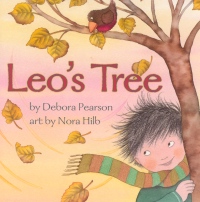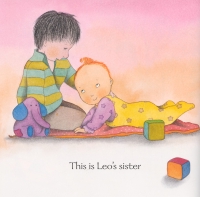| ________________
CM . . .
. Volume XI Number 3 . . . . October 1, 2004
excerpt: This is Leo
Debora Pearson's Leo's Tree is the story of a baby boy and the linden tree which is planted by his parents to celebrate his birth. As the main character grows and changes through the seasons, so does his tree. For example, in the spring, Leo grows hair and the tree grows buds; in the summer, birds and flowers visit them both; and, in autumn, the winds imitate Leo crawling, walking and falling while the leaves tumble down as well. The long winter months emphasize the passage of time, and, when spring returns, both Leo and his linden are transformed. Pearson's tale ends with a new member joining the family and a second tree being planted. From the opening lines, "When Leo was small/His father planted a tree/A scratchy branchy linden tree", author Debora Pearson sets the rhythm and tone of her simple, eloquent story. The "story" is, in fact, a free verse poem that is filled with descriptive language, observations, rhyming phrases and no punctuation. Leo's growth is echoed throughout the story by the growth of his tree. The passing seasons emphasize the many changes in Leo, and Pearson's text links one to another. For example, in the fall, Leo's "rosy cheeks" match the "rosy trees" which are filled with coloured leaves, and winter finds Leo cozy inside his home while the winter winds "blow and blow his snowy tree." As spring returns, Pearson reminds her readers that: Seasons come
The artwork for Leo's Tree was created by illustrator Nora Hilb. Her appealing watercolour paintings convey the story's theme of growth and change through Leo's evolving appearance and the seasonal settings. The paintings contain eye-catching colours yet have an uncluttered quality about them. Readers will find it interesting to note background details such as Leo's trusty stuffed elephant appearing in almost every scene or that his pet cat has kittens of her own by the story's end. Leo's Tree would be a good choice for sharing at home where one could admire the artwork close up; however, it could also be used in a large group setting. Leo's Tree is an uplifting family tale that makes an enjoyable read for both parents and children. The rhythmic language, warm watercolours and cyclical storyline combine to make this book a success. (It would also be helpful for families preparing a young one to welcome a sibling.) Highly Recommended. Lisa Sykes has worked as an early-years teacher and teacher librarian. Two years ago, her family relocated to Ontario along with her son's cherry tree!
To comment
on this title or this review, send mail to cm@umanitoba.ca.
Copyright © the Manitoba Library Association. Reproduction for personal
use is permitted only if this copyright notice is maintained. Any
other reproduction is prohibited without permission.
NEXT REVIEW |
TABLE OF CONTENTS FOR THIS ISSUE
- October 1, 2004.
AUTHORS |
TITLES |
MEDIA REVIEWS |
PROFILES |
BACK ISSUES |
SEARCH |
CMARCHIVE |
HOME |

 The text of the story contains both a comforting reassurance that time is unfolding as it should and a delighted wonder at the remarkable changes that have occurred in Leo, his tree and nature. The arrival of Sophie, Leo's baby sister, begins the cycle of growth again and gently returns the reader back to the opening lines of the story. This makes for a fitting conclusion.
The text of the story contains both a comforting reassurance that time is unfolding as it should and a delighted wonder at the remarkable changes that have occurred in Leo, his tree and nature. The arrival of Sophie, Leo's baby sister, begins the cycle of growth again and gently returns the reader back to the opening lines of the story. This makes for a fitting conclusion.